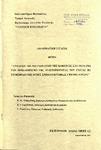| dc.description.abstract | Caffeine metabolism via the N-3 demethylation pathway is sequentially catalyzed by
cytochrome P4501A2 (CYP1A2), xanthine oxidase and N-acetyl-transferase. The activity of
CYP1A2 can be estimated from the urinary metabolic ratio
AFMLJ + IX + 1U
17U
following the
ingestion of caffeine. The purpose of the present study was the development of a reversedphase
high-pressure liquid chromatography (RP-HPLC) procedure for the simultaneous
separation of caffeine and 14 of its metabolites, as well as the quantification of 5-
acetylamino-6-formylamino-3-methyluracil (AFMU), 1-methyluric acid (1U), 1-
methylxanthine (IX), and 1,7-dimethyluric acid (17U).
Spiked blank urine samples were extracted with chloroform/isopropanol (85/15, v/v)
and the mean recoveries of AFMU, 1U, IX, and 17U were 73.6%, 65.2%, 94.3%, and 91.7%,
respectively. The analytical column, a Kromasil 100 C18, 250 x 4.6 mm, 5 pm particle size,
was operated at ambient temperature and the mobile phase consisted of 0.05% acetic acid,
methanol, acetonitrile (92:4:4, ν,ν,ν) delivered at a flow rate of 0.8 ml/min changing to 1.4
ml/min in 11' 30" time. Compounds were monitored at 280 nm and 4-acetamidophenol was
used as internal standard (I.S.). Calibration curves were constructed by plotting peak height
ratios of the four metabolites to the I S. versus theoretical concentrations and were linear at a
range 10-400 pM. The statistical evaluation of the method was examined performing intraday
(n=3) and inter-day (n=5) measurements at low (35 pM), medium (150 pM), and high
(300 pM) concentration levels. The coefficients of variation were <5.3% and <17%
respectively and the accuracy within -8.4% and 14.9%. The limit of detection was 1 pM and
the limit of quantification was set at 10 pM for the four metabolites.
It is concluded that the HPLC method developed in the present study is analytically
reliable and may be a useful tool for assessing CYP1A2 activity. Thus, by collecting spot
urine samples at a time point 8 hours following the consumption of two cups of a strong
coffee (~ 200 mg caffeine), CYP1A2 activity can be determined both in healthy subjects and
in patients with liver disease. | en |



